Project Description:
It was hard to think of moving from the great energy-efficient solar house I had built nine years earlier in Burlington, VT, but I wanted to be closer to my daughter. Looking for housing in Brandon, I realized that I didn’t want to give up the bright warmth, open design and energy efficiency of my “old” house. The only answer was to build. Everything fell together, as I found a small lot with southern exposure in an established neighborhood, with houses close by on each side, and within walking distance of the center of Brandon. I visited my builder, Chuck Reiss’ new house on the Green Building Tour and got excited about new developments in the field and the possibility of reaching for net-zero. I immediately began designing, and Chuck agreed to bring his crew down to Brandon. Final plans were drawn up by Dora Coates of Dovecote Designs, with suggestions from my son-in-law, David Martin, who trained as an architect.
Much of the house design is carried over from my previous home. I had known from experience that Chuck’s building techniques (double walls with dense pack cellulose, careful sealing of all penetrations) would give me a tight envelope. The water-to-water geothermal heat pump greatly reduces the energy needed to heat the house and, as a bonus, gives me the comfort of radiant floor heat, as well as freedom from radiators. I keep the heat at a comfortable draft-free 67º. Based on the reduced heat load, solar hot water and energy efficient appliances, Chuck calculated the optimum amount of solar needed to reach net-zero.
The few north-facing windows are triple-glazed, and the large south-facing windows and skylights keep the house toasty warm on the coldest of sunny winter days, while being shaded in the summer by the large overhang of the roof. There is no need for air conditioning. The windows provide splendid natural light, supplemented, when needed, by florescent lighting. Insulating shades, which open from top or bottom, provide flexibility in privacy and shading. The open design, with its upstairs loft and cathedral ceiling, lets the warm air and light circulate through the whole house. All living areas but the study have natural light from windows to the south.
The 45º angle of the roof not only optimizes the solar collection, but also sheds snow quickly, and it provides excellent high-ceiling storage space, much needed in a house on a slab.
I sacrificed nothing in my move from Burlington (save proximity to Great Harvest Bread). I am glad to have been able to pass another five-star energy efficient house on to a new owner, and I have gained the immense satisfaction of paying no utility or heat bills, except about $30 a year for propane for stove-top cooking (more than made up for by about 1,000 extra Kwh fed to the grid). As Chuck says, I have become a “micro utility” and, he asks, “Why isn’t every house being built this way?”
Building Type Summary:
Address:
Elevation:
Lat. / Long.:
Location Type:
Köppen Climate Type:
Climate Region:
Solar Insolation:
Annual HDD :
Annual CDD:
HDD Base Temp:
CDD Base Temp:
Occupancy Type and Details:
Occupancy statement:
For the 12-month period before the inverter failure the house was occupied 353 days (12 days of vacation) and 428 person days.
Conditioned Floor Area:
Multiple buildings?:
Total number of units in project (all buildings):
Total floor area of project (all buildings):
Historic?:
Completion date:
Energy Highlights:
Renewable Energy
24 Sanyo HIT210N 210 watt solar roof-mounted PV panels
Solectra PV 15300 inverter
2 Heliodyne roof mounted Golbi 408 solar hot water panels 68 kBTU/ clear day
Superstor Contender Solar tank (SE series, electric back-up), GFX heat-recovery coil for 2nd floor bath
Peak power of PV array 5040 watts
Projected annual production of PV array 6048 KWH
Actual production of PV array 11/22/11 - 11/30/12 was 5,391. This period included an inverter failure from late April to June 15, with 1 ½ months of lost production. No data available for the earlier period.
Annual renewable energy generated:
Electric Utility Company:
Datasets and Utility Bills sources and reliability:
Data sourced from onsite meters and utility bills.
Electricity amount (imported from grid):
Electricity amount (credited or exported to grid):
Net electricity usage (purchased electricity):
Subslab assembly:
Subslab 4” extruded polystyrene
Slab edge assembly:
Slab edge 2” of foam
Foundation wall assembly:
House is on a slab, no basement
Above grade wall assembly:
Above-grade wall 2x4 double wall (9.25”cavity) dense pack cellulose
Flat attic assembly:
Flat attic 2x10 and 2x8 (16.5” cavity) dense pack cellulose
Cathedral ceiling assembly:
Cathedral ceiling (including sloped attic ceiling) 2x12 with horizontal strapping (12.75” cavity) dense pack cellulose
Space heating - Manufacturer & Model:
Space cooling - Manufacturer & Model:
Domestic hot water - Manufacturer & Model:
Ventilation - Manufacturer & Model:
Process:
It was hard to think of moving from the great energy-efficient solar house I had built nine years earlier in Burlington, VT, but I wanted to be closer to my daughter. Looking for housing in Brandon, I realized that I didn’t want to give up the bright warmth, open design and energy efficiency of my “old” house. The only answer was to build. Everything fell together, as I found a small lot with southern exposure in an established neighborhood, with houses close by on each side, and within walking distance of the center of Brandon. I visited my builder, Chuck Reiss’ new house on the Green Building Tour and got excited about new developments in the field and the possibility of reaching for net-zero. I immediately began designing, and Chuck agreed to bring his crew down to Brandon. Final plans were drawn up by Dora Coates of Dovecote Designs, with suggestions from my son-in-law, David Martin, who trained as an architect.
Much of the house design is carried over from my previous home. I had known from experience that Chuck’s building techniques (double walls with dense pack cellulose, careful sealing of all penetrations) would give me a tight envelope. The water-to-water geothermal heat pump greatly reduces the energy needed to heat the house and, as a bonus, gives me the comfort of radiant floor heat, as well as freedom from radiators. I keep the heat at a comfortable draft-free 67º. Based on the reduced heat load, solar hot water and energy efficient appliances, Chuck calculated the optimum amount of solar needed to reach net-zero.
Finances Description:
Built in 2009-2010
Total Cost of Project:
Value of Tax Credits for renewable energy systems:
Federal incentives:
Incentives and federal credits totaled $29,167.00
NESEA Awards:
2013 Zero Net Energy Building Award Runner-Up
Special architectural measures:
The 45º angle of the roof not only optimizes the solar collection, but also sheds snow quickly, and it provides excellent high-ceiling storage space, much needed in a house on a slab.
The few north-facing windows are triple-glazed, and the large south-facing windows and skylights keep the house toasty warm on the coldest of sunny winter days, while being shaded in the summer by the large overhang of the roof. There is no need for air conditioning. The windows provide splendid natural light, supplemented, when needed, by florescent lighting. Insulating shades, which open from top or bottom, provide flexibility in privacy and shading. The open design, with its upstairs loft and cathedral ceiling, lets the warm air and light circulate through the whole house. All living areas but the study have natural light from windows to the south.
Energy Use and Production Documentation:
Subslab R-value:
Above grade wall R-value:
Flat attic R-value:
Cathedral ceiling R-value:
Average window U-factor:
Solar Heat Gain Coefficient:
Door U-Factor:
Cost per square foot of Conditioned Space:
Project Photos:
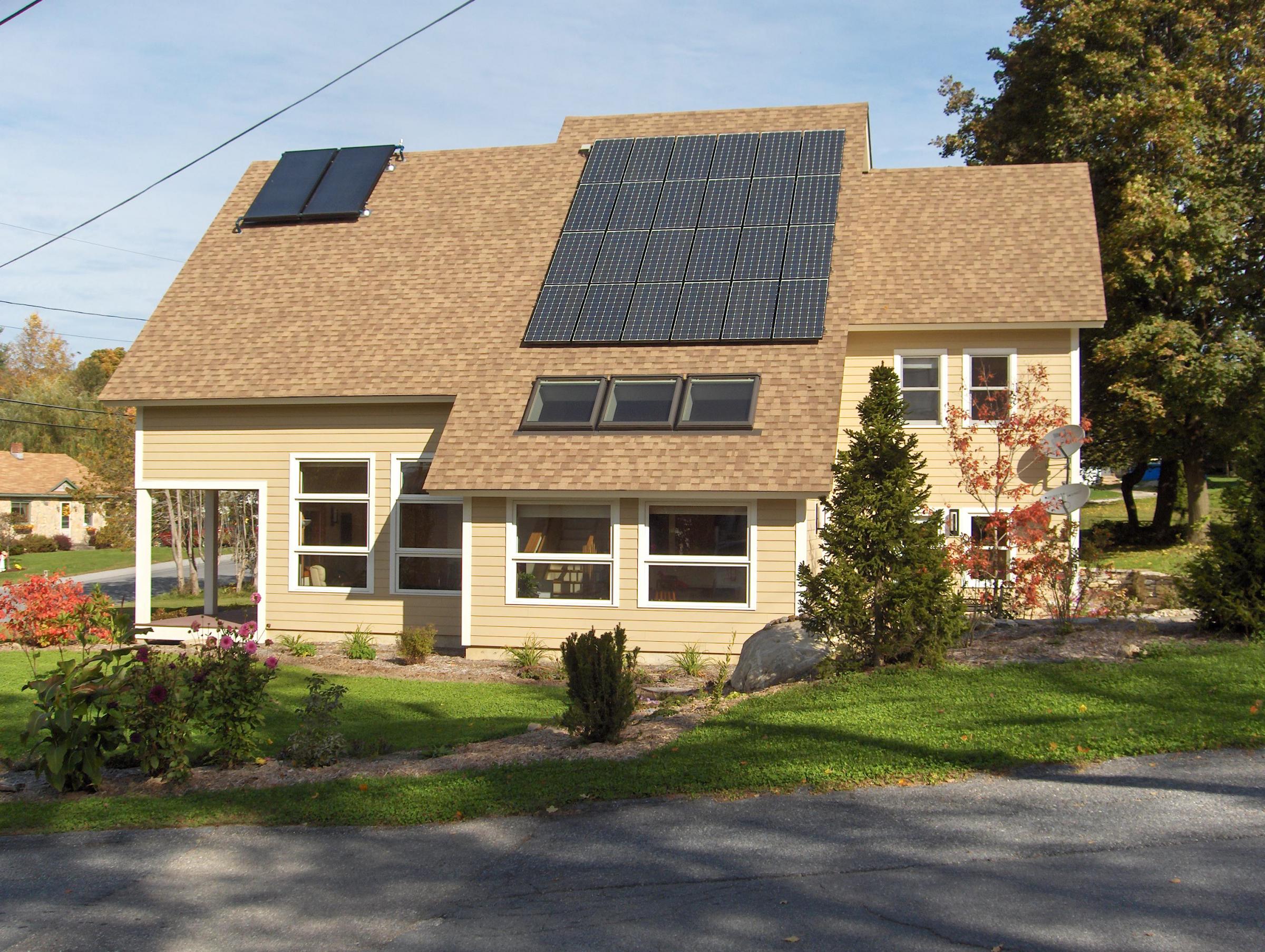
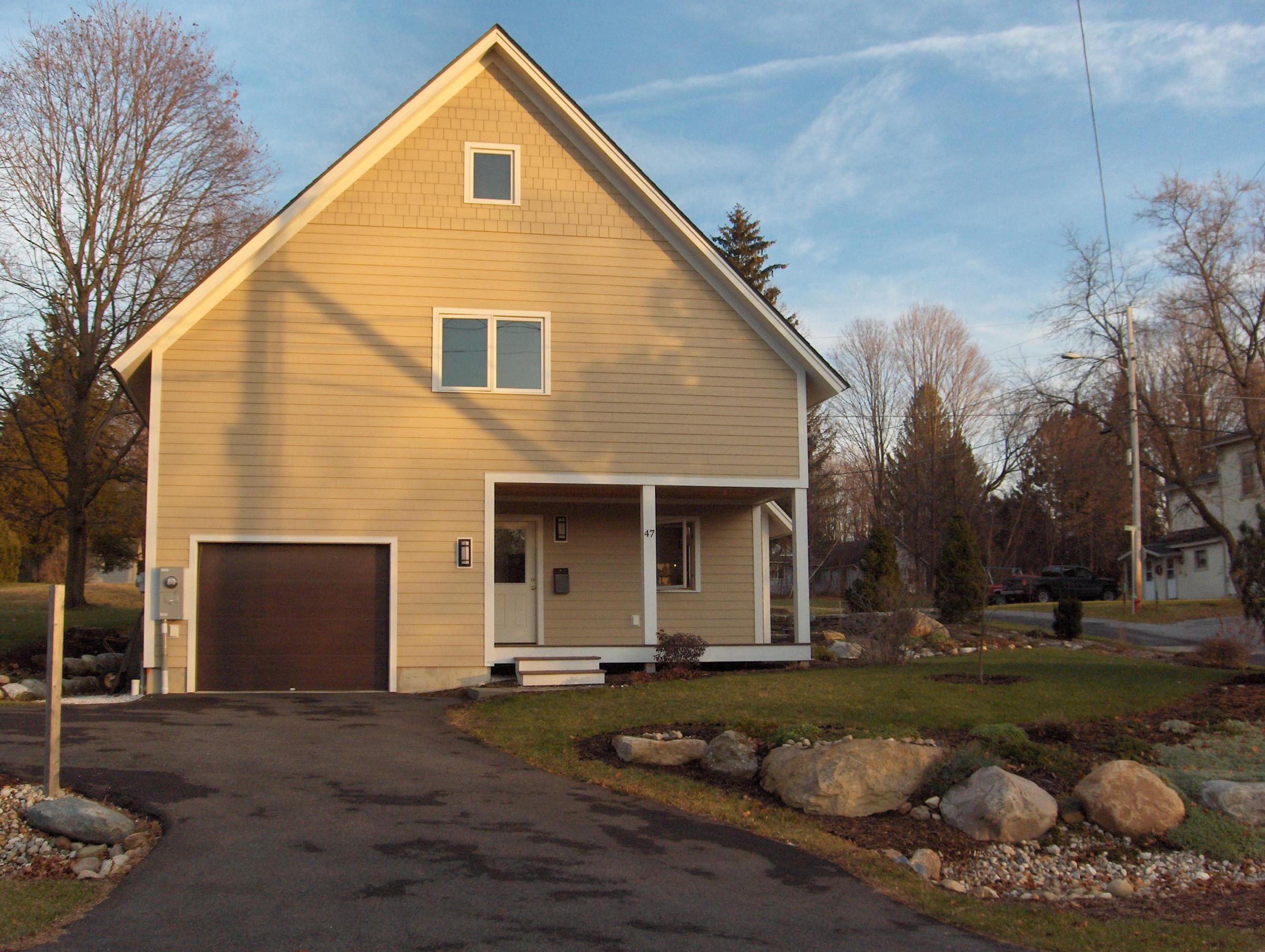
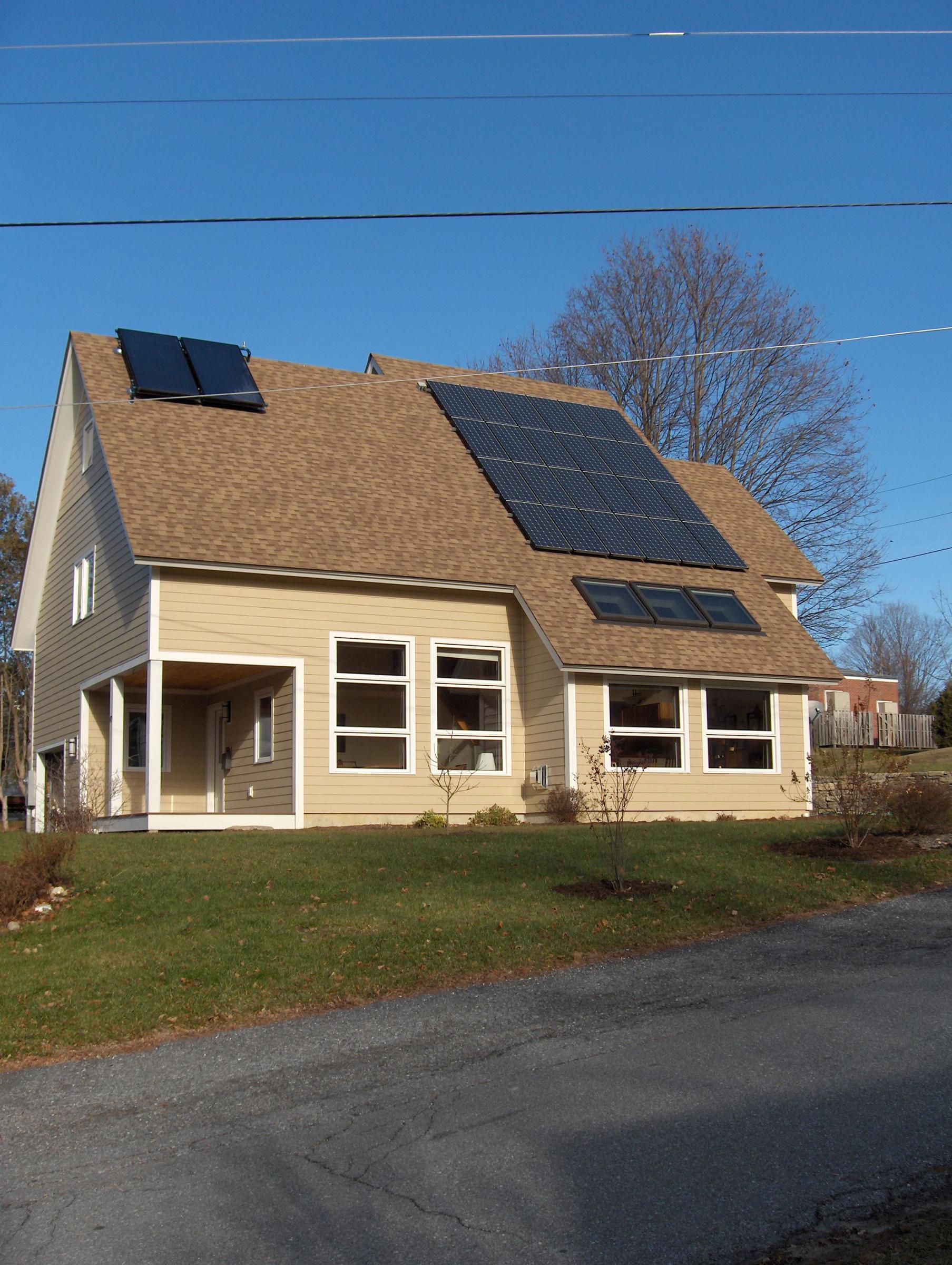
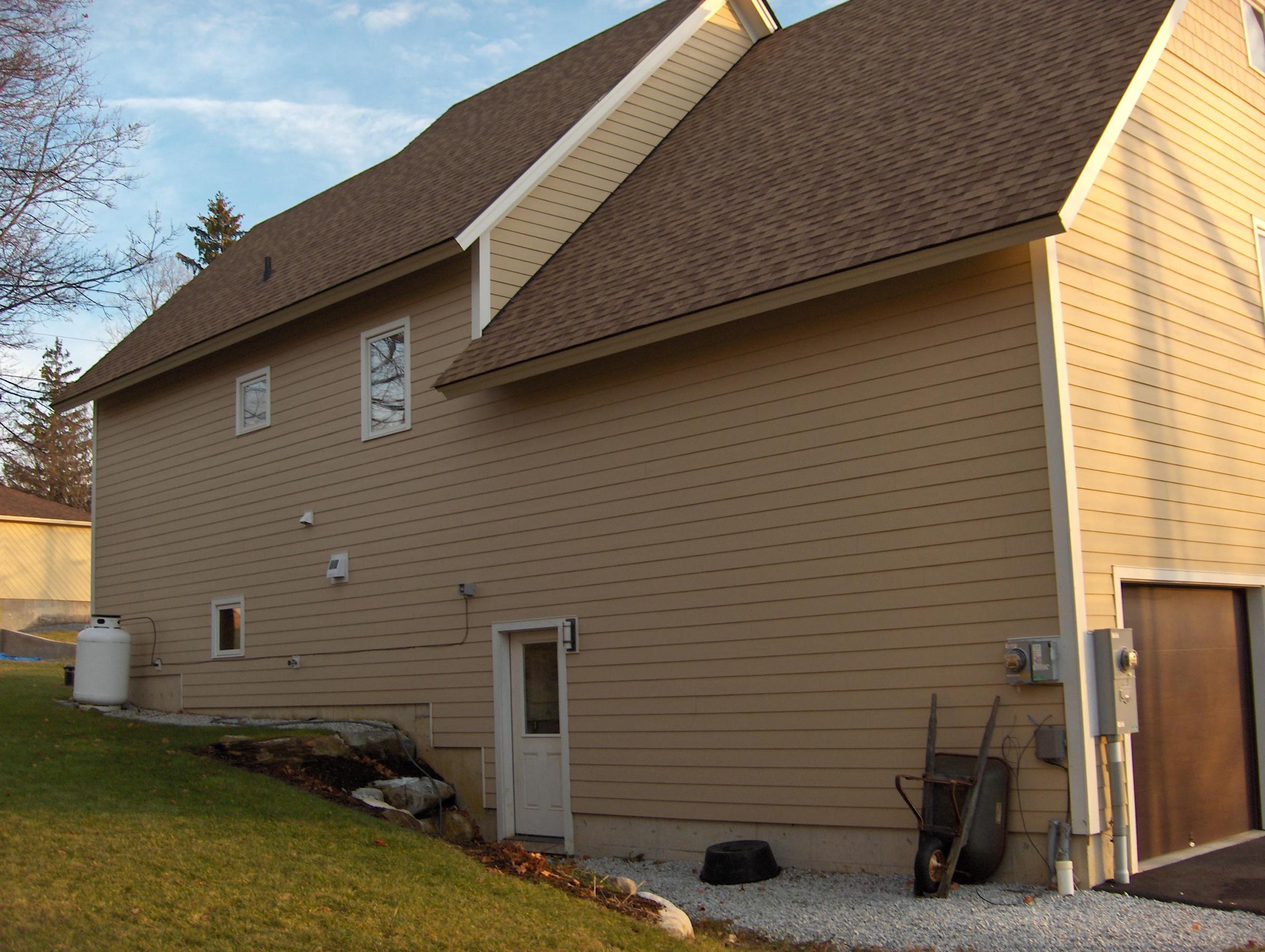
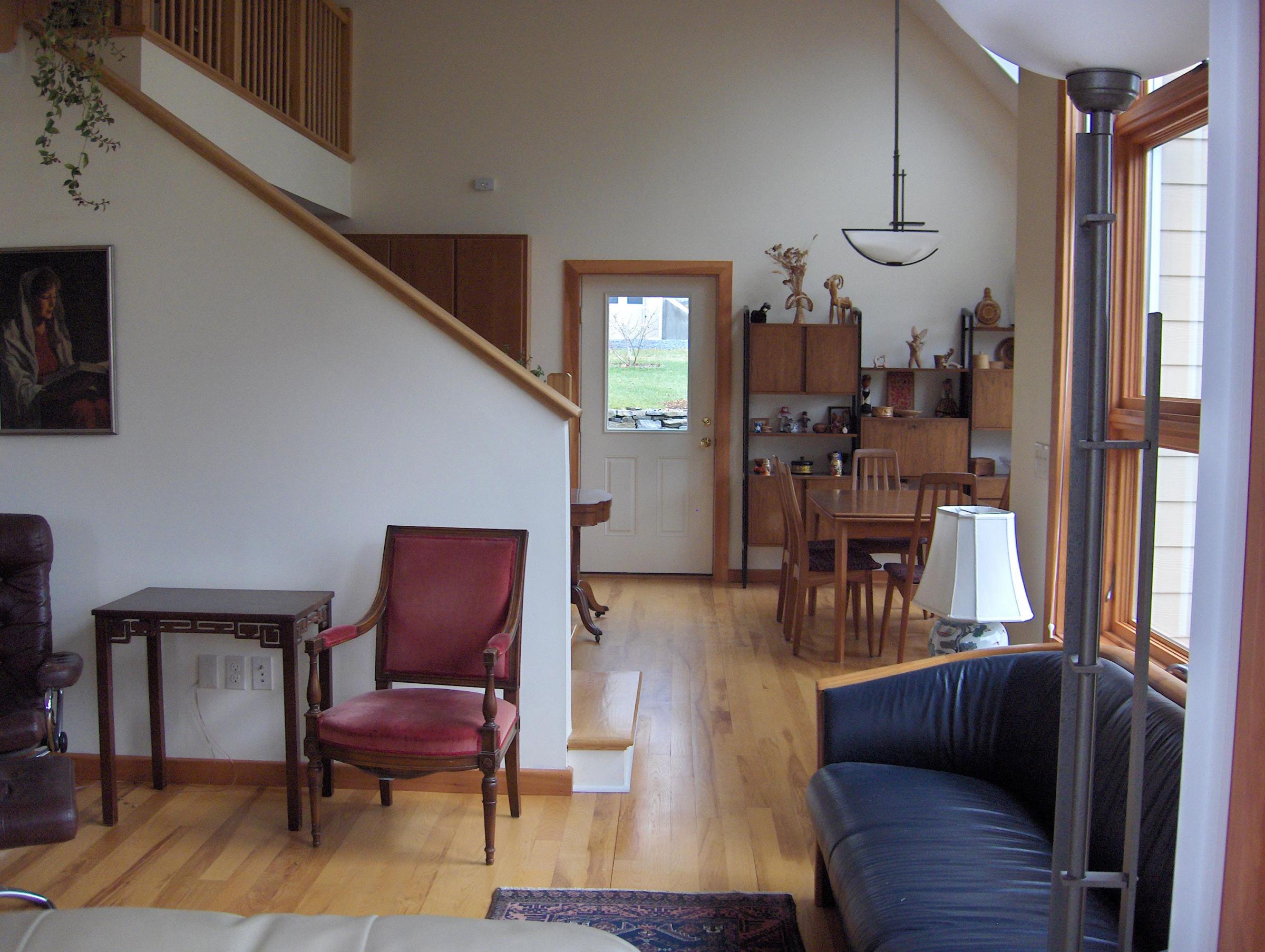
Number of Bathrooms:
Renewable Energy Sources:
Other Purchased Fuels Description:
Irving Energy - 24 gals propane delivered annual for stovetop cooking.
Window Description:
North-facing: Marvin Windows, 1 clad casement and 2 awning tripane u=.25 SHGC =.25
West-facing: 1 Marvin clad casement double pane u=.35 SHGC =.47
East-facing: 2 Marvin clad double-hung u=.30 SHGC =.30
South-facing: 4 Marvin clad double-hung u=.30 SHGC=.30
10 Marvin clad casement double pane u=.35 SHGC=.47
3 Velux VS skylights u=.50 SHGC=.29
*Only windows on walls within the conditioned space are listed. Over 75% of the surface of these windows faces south.
Door Description:
Doors: 4 (including attic door) ThermaTru R-7 u=.14
Number of Bedrooms:
Team Members:
Chuck Reiss (Builder)
Dora Coates (Designer)
Pat Hanson (Homeowner)

Mechanical Equipment Installation Details and Comments:
Superstor Contender Solar tank (SE series, electric back-up), GFX heat-recovery coil for 2nd floor bath